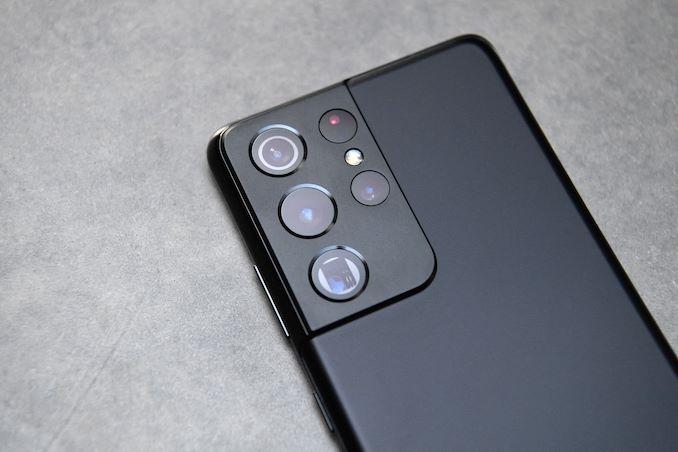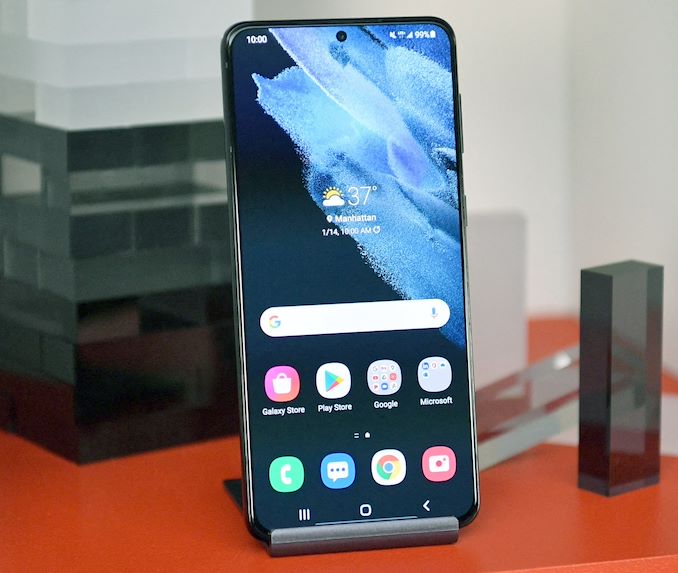Samsung Announces Galaxy S21, S21+ & S21 Ultra: Cheaper Baseline, Higher High-End
by Andrei Frumusanu on January 14, 2021 10:00 AM EST
Today, Samsung is taking the virtual stage to release the new Galaxy S21 series of devices, including the Galaxy S21, S21+ and S21 Ultra. In a time where smartphones become more and more expensive, Samsung is attempting a different approach this year, and instead of increasing device prices, actually reduces them – at least for the baseline S21 and S21+ models. The move is an interesting one, however very much dilutes the Galaxy S series as a flagship line-up of devices, with Samsung doing some feature compromises that wouldn’t had been thinkable in past iterations of the series.
Meanwhile, the Galaxy S21 Ultra continues to be Samsung’s focus point in delivering true no-compromises flagship experiences and features, with this year’s iteration aiming for more capabilities than ever before, including a new quad-camera setup, the only device in the line-up now featuring a 1440p screen at 120Hz, and for the first time now also offering S-Pen support as an external accessory. Naturally, this continues to come at a very high(er) end cost point, creating a larger discrepancy within the line-up than ever before.
| Samsung Galaxy S21 Series | ||||
| Galaxy S21 | Galaxy S21+ | Galaxy S21 Ultra | ||
| SoC | Qualcomm Snapdragon 888 1x Cortex-X1 @ 2.84GHz 1x1024KB pL2 3x Cortex-A78 @ 2.42GHz 3x512KB pL2 4x Cortex-A55 @ 1.80GHz 4x128KB pL2 4MB sL3 |
|||
| Samsung LSI Exynos 2100 1x Cortex-X1 @ 2.9GHz ? pL2 3x Cortex-A78 @ 2.8GHz ? pL2 4x Cortex A55 @ 2.2GHz ? pL2 ?MB sL3 |
||||
| Display | 6.2-inch 2400 x 1080 (20:9) 48-120Hz 1300nits peak |
6.7-inch 2400 x 1080 (20:9) 48-120Hz 1300nits peak |
6.8-inch 3200 x 1440 (20:9) 10-120Hz 1500nits peak |
|
| SAMOLED HDR10+ 120Hz Refresh Rate |
||||
| Dimensions | 151.7 x 71.2 x 7.9mm 171g (mmWave), 169g (sub6) |
161.5 x 75.6 x 7.8mm 202g (mmWave), 200g (sub6) |
165.1 x 75.6 x 8.9mm 229g (mmWave), 227g (sub6) |
|
| RAM | 8GB | 8GB | 12 / 16GB | |
| NAND Storage |
128, 256GB | 128, 256 GB | 128, 256, 512 GB | |
| Battery | 4000mAh (15.4Wh) typ. 3880mAh (15.01Wh) rated |
4800mAh (18.57Wh) typ. 4660mAh (18.03Wh) rated |
5000mAh (19.25Wh) typ. 4855mAh (18.87Wh) rated |
|
| Front Camera | 10MP 4K video recording F/2.2, 80-degree |
40MP 4K video recording F/2.2, 80-degree |
||
| Primary Rear Camera | 79° Wide Angle 12MP 1.8µm Dual Pixel PDAF |
79° Wide Angle 108MP 0.8µm DP-PDAF 3x3 Pixel Binning to 12MP 8K24 Video Recording |
||
| fixed f/1.8 optics OIS, auto HDR, LED flash 4K60, 1080p240, 720p960 high-speed recording |
||||
| Secondary Rear Camera |
76° Wide Angle (Cropping / digital zooming telephoto) 64MP 0.8µm f/2.0 optics, OIS 8K24 Video Recording |
12° Telephoto (10x optical) 10MP f/4.9 prism optics, OIS |
||
| Tertiary Rear Camera |
- | 3x optical 10MP f/2.4 |
||
| Quartenary Rear Camera |
120° Ultra-Wide Angle 12MP 1.4µm f/2.2 |
|||
| Extra Camera |
- | Time of Flight (ToF) 3D Sensor | ||
| 4G / 5G Modem |
||||
| Snapdragon 5G TBC |
||||
| Exynos 5G TBC |
||||
| SIM Size | NanoSIM + eSIM | |||
| Wireless | 802.11a/b/g/n/ac/ax 2x2 MU-MIMO, BT 5.1 LE, NFC, GPS/Glonass/Galileo/BDS |
+ WiFi 6E | ||
| Connectivity | USB Type-C no 3.5mm headset |
|||
| Special Features | Under-screen ultrasonic fingerprint sensor | |||
| (Qualcomm QC 2.0, Adaptive Fast Charging, USB 3.0 PD PPS), reverse wireless charging (WPC & PMA), Ultra Wideband IP68 water resistance |
||||
| Launch OS | Android 11 with Samsung OneUI 3.1 | |||
| Launch Prices | 128GB 5G: $799 / €849 / £769 256GB 5G: $849 / €899 / £819 |
128GB 5G: $999 / €1049 / £949 256GB 5G: $1049 / €1099 / £999 |
128GB 5G: $1199 / €1249 / £1149 256GB 5G: $1249 / €1299 / £1199 512GB 5G: $1379 / €1429 / £1329 |
|
Starting off with the heart of the new phones, that’s one area where the new S21 series don’t differ – the trio of devices are either powered by Qualcomm’s new Snapdragon 888, or Samsung LSI’s Exynos 2100. Both chipsets are characterised by being among the first Samsung 5nm manufactured SoCs in the market, and both feature Arm’s newest Cortex-X1 performance core at either 2.84GHz or 2.9GHz. The Exynos chip has slightly higher frequencies on its middle and little cores, and should give it a small multi-threaded performance advantage. Both promise large GPU performance upgrades over the S20 SoC generations, and both chips are now integrated with an internal 5G modem instead of an external discrete one.
Unlike past years, the SoC situation on the Galaxy S21 series this year should be significantly more balanced as both the Snapdragon 888 and Exynos 2100 share a lot more commonalities, featuring the same CPU IP, being manufactured on the same process node, and also quoting similar performance figures when it comes to things like NPU and GPU performance, which is good news for users out there which in the past might have seen inferior device experiences with particularly the Exynos variants of Galaxy phones.
In terms of DRAM, the S21 and S21+ come with 8GB. This is actually a downgrade compared to the S20 series as the 5G variants there had been configured with 12GB. The S21 Ultra remains an option of either 12 or 16GB variants, depending on the storage size, with the 16GB option only available for the 512GB variant.
The S21 and S21+ come in either 128 or 256GB storage, while the S21 Ultra also has a 512GB option. What’s controversial about this generation’s devices is the removal of the microSD slot. While it’s true that microSD’s have become quite outdated and the industry has failed to transition to a newer standard, Samsung here is simply removing the option without either giving an alternative or increasing the base storage of the phones.
Galaxy S21 Ultra - The new "True" Flagship
Starting off with the Galaxy S21 Ultra, Samsung here is equipping the new mega-flagship device with its best display ever, basing off on the work of the brand new panel technology that was introduced in the Galaxy Note20 Ultra which uses a new hybrid oxide backplane. The new display is at the expected 3200 x 1440 resolution, however unlike last year’s devices, Samsung has now finally enabled the full 120Hz operation at this native software rendering resolution as well – joining in the rare few devices capable of this, such as the OnePlus 8 Pro. The usage of the new panel technology and VRR should allow the S21 Ultra to offer this resolution and refresh rate without too many compromises in battery life. Last year we saw that the Note20 Ultra’s screen VRR feature depended on ambient brightness, with it not working in dim situations – it’s to be seen if the S21 Ultra has a similar limitation or if Samsung’s engineers have been able to optimise this limitation away.
One big feature addition of the S21 Ultra is the addition of a Wacom digitiser in the screen, a feature that to date had always been reserved for the Note series. Unlike the Note series, the S-Pen isn’t integrated into the phone, but is rather an external accessory.
Design-wise, the front of the Galaxy S21 Ultra looks to be quite similar to that of the S20 Ultra, however Samsung has actually slightly reduced the footprint of the phone as the screen is now 6.8” instead of 6.9”.
The new Galaxy S21 Ultra is actually slightly smaller than the S20 Ultra, being 0.4mm narrower and 1.8mm shorter, although it’s now also 0.1mm thicker. It’s still a large phone, and actually it’s now 7 or 9g heavier than its predecessor, weighing up to 229g in the mmWave variant.
On the back of the phone, we’re seeing a more significant redesign of the devices, particularly around the cameras. The Galaxy S20 Ultra’s camera bump really wasn’t one of pretty aesthetics, with more of a feel towards functionality – making it feel out of place and stand out in context of the rest of the phone design. The Note20 Ultra had slightly improved upon this with a somewhat rearranged design, however the new S21 series and the new S21 Ultra really showcase a large design shift in the camera bump.
The “bump” is actually now a flowing with the frame of the phone (though it’s still a separate piece), starting off at the edges and corner of the phone, instead it being a standalone design element raised within the back glass panel. With this design, Samsung gets rid of two sharper edges on the part of the camera bump. Instead of a larger glass cover over the camera assembly, the individual cameras seem to have their own smaller glass covers, recessed against the metal frame bump.
It’s to be noted that this camera frame looks to be flat, in contrast to past generation devices which have a very small metal lip upon which the phone rests on. I don’t know how this will play out in terms of scratches – usually the lip itself would get damaged whereas here it could be that the whole surface would be more prone to scratches.
New Quad-Camera Setup
On the camera side of the S21 Ultra, we’re now seeing a move towards a quad-camera setup, with Samsung changing up the telephoto camera formula yet again.
First of all, the new main camera seems to be of similar specifications as on the S20 Ultra and Note20 Ultra: a 108MP sensor within an f/1.8 optics system with OIS. It’s not clear if this is the same generation sensor as last year of if Samsung has been able to upgrade it.
Samsung here still promises 8K video recording and even now adds 12-bit RAW video recording capabilities – however if this still uses a sensor crop mode, it’ll still result in a not very optimal resulting focal-length compared to the native optics of the module.
On the ultra-wide, we’re seeing the same 12MP f/1.4 f/2.2 120° module as on the Galaxy S20 series – which we really can’t complain about as it was a great module and amongst the best performers of the year.
Where Samsung has made larger changes now is in the telephoto department. I really was not a big fan of the S20 Ultra’s telephoto module here which had offered a 4x optical magnification. On the S21 Ultra, Samsung actually increased this magnification ability to 10x through a redesigned prism optics module. The longer focal length comes at a cost of a decrease in aperture from f/3.5 to f/4.9, as well as a move from a 48MP sensor to a newer smaller 10MP unit. This means that although the S21 Ultra will have greater optical telephoto capabilities, it’ll come at a cost of light capture ability.
Unlike the S20 Ultra and the Note20 Ultra however, Samsung now makes up for the compromises in the new prism telephoto module by adding an additional secondary 3x optical module with f/2.4 aperture and a 10MP sensor. Essentially, this solves the great gap in optical magnification between the main module and the new further reaching telephoto module, and also hopefully solves the quality gap in this common focal range that I consider to be more important for every-day photography.
Galaxy S21 & S21+ - Cheaper, but Ugly Compromises
While the Galaxy S21 Ultra looks to be a great device, checking off every single feature you’d expect in a 2021 flagship phone, the new Galaxy S21 and S21+ are more controversial devices, really questioning Samsung’s product line-up as a whole.
First of all, the biggest feature disparity of the new S21 “baseline” models is that they are not getting the same top-of-the-line displays as the new S21 Ultra. In fact, the new displays are seemingly somewhat of a downgrade compared to even last year’s Galaxy S20 series. Samsung here has decided to downgrade the panels to 2400 x 1080 resolution, still maintaining a 120Hz refresh rate.
I find this choice actually extremely negative, and I see it as Samsung shooting themselves in the foot in terms of their device line-up and essentially discarding a very important aspect of what a Galaxy S-series device is. For the past decade, no matter what generation Galaxy S-phone you look at, the one thing that was always the key differentiator compared to other device models and competitor models is that the S-line phones always had no-compromise displays. Samsung used to actually take pride in this fact, and consumers could always count that each generation would be the able to achieve the best of what’s technically possible in a phone display.
Starting last year with the Note20, and unfortunately continued this year with the S21 and S21+, this doesn’t seem to be the case anymore, and essentially Samsung is diluting a key aspect of what their flagship devices were always known for.
I understand that Samsung is trying to price the devices lower, but it’s just not possible that an S21+ comes with a 1080p screen when for example a cheaper new Xiaomi Mi 11 is able to feature a 1440p 120Hz display.
Other design differences to last year’s models is the fact that the displays now are “flatter”, with almost no side-curvature at all. This is actually mostly a positive for a majority of users, as after several years of side curvature experiments, it seems that most people prefer functionality. Personally, I liked the subdued curvature of the S20 series phones – I’ll have to see how the S21 feel in hand before arrive to a proper opinion on the new devices.
The new S21 and S21+ phones are wider than their predecessors, with the S21 growing by 2.1mm in width, and the S21+ being 1.9mm wider. This actually has large implications on the usability and the general form-factor of the phones. The new S21+ actually has yet again gotten heavier this generation, weighing in at 200/202g. The extra weight is somewhat explained by the larger battery capacity which has grown from 4500 to 4800mAh, but it’s still a quite large departure compared to past years – the Galaxy S10+ only weighed 175g.
On the back of the phones, the new camera setup looks quite nice and follows the same design elements we described earlier for the S21 Ultra. Although at first glance it looks like the camera bump flows with the frame here as well, it’s actually constructed differently to the S21 Ultra, and there’s an extra in-between element between the frame and the camera cover element. Undoubtedly this would be part of a cost-cutting measure to reduce the manufacturing cost of the piece.
In regards to the camera modules themselves, it’s relatively straightforward: They’re the same as on the Galaxy S20 series. This includes a main 12MP camera sensor with large 1.8µm pixels with f/1.8 aperture and OIS, a secondary wide-angle module with a 64MP camera sensor which serves both as the 8K capture module as well as a “telephoto” module that is able to crop-magnify quite well thanks to its massive native resolution, as well as the same 12MP f/2.4 120° ultra-wide-angle module as on the S20 series and the S21 Ultra.
I’m actually quite happy with this camera setup and I think it was one of the best and most well-balanced configurations in 2020, so reusing it on the S21 series is a general positive in my view.
One change in the new design is the move of the flash to the phone back panel, as well as the removal of the ToF sensor on the S21+ (The S20 never had it).
Too Many Compromises?
While the S21 Ultra seems like a proper follow-up to last year’s models, the new S21 and S21+ feel like they’re doing a lot of compromises for the price drop that they are offering.
Particularly the Note20’s “glasstic” back was a point of contention alongside the 1080p display panel – and Samsung here is doing the very same choices for the S21, partly also to the S21+. Furthermore, there’s other feature compromises this generation such as the removal of the microSD slot, and also long-term component feature discrepancies such as the fact that new WiFi 6E connectivity is solely reserved for the Galaxy S21 Ultra.
While we’ll have to see how the S21 series are being received, I’ve made a poll today on Twitter regarding the Note20, and how users perceived that device, whether it was a good compromise, or not fulfilling users’ expectations:
Unfortunately, even many months after the release of the Note20, the general response to the device is massively one-side and very much negative, which pretty much lines up with my initial impressions of the phone.
Samsung’s choice to apply the same design and feature compromises to the S21 series is I feel like a massive mistake, and Samsung crippling its own device line-up. I don’t know what they’re attempting here – maybe they’re trying to redirect users towards the more complete and expensive Ultra models.
If that is indeed what they’re trying to do, I feel like they’re going about it the wrong way. The S21 and S21+ look like fine devices, but still too expensive for what they are, especially since there’s now very major feature overlap with the cheaper phones, even within Samsung’s own series, such as the Galaxy S20 FE. Besides the SoC, I actually feel like the S21 and S21+ are actual downgrades this year compared to the S20 and S20+.
Apple’s line-up of iPhone 12 mini, iPhone 12, iPhone 12 Pro, and iPhone 12 Pro Max makes more sense to me to cater to the wider range of users. For the S21 series, I feel like the S21 Ultra should have been called the “S21 Ultra+” and we’re missing a smaller, slightly cheaper, maybe without the 10x telephoto, but otherwise feature identical S21 Ultra device.
$200 Cheaper Sounds Good Though
There are no such thing as bad devices, only bad prices. In this regard, Samsung’s S21 and S21+ come in at $200 cheaper compared to their predecessors. In that regard, it might actually be a winner combination, with the Galaxy S21 for example starting at $799. In the US, that’s actually only $100 more than a Pixel 5 while offering a vastly superior device in every regard.
The S21+ also goes down from $1199 to $999, so it’s a also a relatively good compromise if you can live with the FHD+ screen.
Meanwhile, the S21 Ultra is also starting $200 cheaper, at $1199 compared to the initial launch price of $1399 of the S20 Ultra. Given that the S21 Ultra hasn’t seen any feature compromises, you could argue that we’re seeing much better value generation-on-generation compared to the S21 and S21+.
Samsung is also posting some reasonable prices for the upgrade from the 128GB to the 256GB models, with the upgrade costing only $/€/£50 – a much better upgrade path than past generations where the jump usually cost 100 more of your bills.
These are generally sensible prices, and I think the base S21 and the S21 Ultra seem like they’ll be the most popular devices among the line-up. The S21+ however feels like it’s a bit off the mark, and we might see better options from the competition, particularly now that the + variant is losing its size and weight sweet-spot.
In the US, the new Galaxy S21 series will be available for shipping January 27th with preorders starting today.
Related Reading:
- The Samsung Galaxy S20+, S20 Ultra Exynos & Snapdragon Review: Megalomania Devices
- Samsung Announces The Galaxy S20, S20+ and S20 Ultra: 120Hz, 5G, Huge Batteries, Crazy Cameras and $$$
- Samsung Announces Exynos 2100 SoC: A New Restart on 5nm with X1 Cores
- Qualcomm Details The Snapdragon 888: 3rd Gen 5G & Cortex-X1 on 5nm



















136 Comments
View All Comments
Silver5urfer - Thursday, January 14, 2021 - link
So far list of downgrades...1440P to 1080P even on Plus
RAM downgraded
Wireless charging Wattage downgraded
Plastic back ? WTF
No SD slot
No 3.5mm jack
No charger in the box
No earphones in the box
Same old non removable BS battery and ugly design. I hope people are not this stupid to buy this crap, I know many buy every year for unknown reasons. This is even worse if they buy into this bullshit.
And SD card slot is not about space only. It has a legit case of storing valuable data when in the need of emergency. Having an unencrypted SD Slot will let me store all my FLAC recordings (yeah LG phones do that and more..) and 4K videos, PDF documents, Word documents. Images which are personal and have private data. All of them will be on a physical disk. If the phone dies off in any way or anything happens to the phone, I can simply plug it into SD adapter and check them on PC as I need. That's a huge huge bonus. This is a pocket computer not a stupid ePeen Snapchat and social media crap device. I can list more like ROMs, Password files, tons of keys, Certificates etc when needed, VPN profiles and MORE... Removable Storage on Android and it's Filesystem is the greatst thing ever for a smartphone, and a Pocket Computer should act as an on the go computer not a castrated overpriced paperweight.
Fuck off Samdung. You screwed it up real bad this time. I hope LG and Sony step up more, so far they are the only ones having all boxes ticked. Even ASUS threw in towel shamelessly with Zenfone 7 while ZF6 had all of the features.
jiffylube1024 - Thursday, January 14, 2021 - link
You're going back two generations for the no 3.5mm jack. I *hate* that downgrade too btw, but it was already gone in the S20's. Unfortunately, this is Samsung conforming to market trends with the SD card slot drop. It sucks but SD cards are turning into that "special use case" category.The phone is $200 cheaper generation to generation on MSRP ($300 for the S21+) and swapped materials on the back (S21 only), and you don't get a charger or earphones in the box. I'd say that is them actually passing the savings on to the consumer! You lose about $50 worth of hardware and get back $200-300 on the price.
But yeah, it's the internet so Samsung you suck!!!
BurntMyBacon - Thursday, January 14, 2021 - link
I can see the argument (though don't agree) that it is a good idea to remove the 3.5mm jack. In the pursuit of thinner and lighter devices, the 3.5mm jack takes up a lot of area that can be better used for more powerful radio chips or just a little more battery. Also, it is easier to water/dust proof without it. Since I don't subscribe to the thinner and lighter mantra and don't always see good use of the freed up spaced, I find some of these arguments a little lacking. That said, there is at least an argument to be made.When it comes to removing the SD Card, the only two arguments that they make are "everyone else is doing it (conforming to industry trends)" and "SD Cards are old". I refuse to even acknowledge the first argument as nobody in the legal system, my work place, or my social groups would accept that as the basis for any decision. While the second is true, the age of the technology has not prevented it from achieving its purpose. It still retains all the benefits of being removable, despite its age. While it is slower than internal storage, its speed does not currently preclude its primary function. I think it is more likely that the deciding factors are the unspoken arguments that removing the slots saves a little in cost and forces people who are desperate to get extra storage to upgrade to the more expensive model.
Everything about this launch looks designed to push as many people to the top model as possible. Downgrade the screen, ram, materials, etc. from the last generation for the lower and mid models while making the top end model an upgrade in almost every respect. Lack of SD Card also forces you to move up models to get to your desired storage. You could argue that they needed to do all that to lower the price on the lower and mid models, but I find that unconvincing based on both the fact that there are competitors with arguable better specs for less cost and the fact that the top model was a clear upgrade and still managed to drop the same $200 off of its MSRP as the others did. Incidentally, the $200 price drop on the top model also makes it more appealing. To me this appears less like Samsung adjusting to competition and industry trends than creating more segmentation within their line-up to push as many consumers to higher end models as possible.
s.yu - Sunday, January 17, 2021 - link
There's simply far too little benefit to removing the jack that there's absolutely no valid argument for it from the perspective of the consumer. Samsung publically admitted that it added all 100mah to the battery which adding 0.1mm to the thickness absolutely will not add. https://www.theverge.com/2019/8/7/20758050/samsung...The S21U is now made somewhat competitive though factoring in a 20-30% drop in street price after 3-4 months per usual for Samsung, but still not for me since it doesn't have either a separate 3.5mm nor a second C port like ROGP3. Otherwise considering how SD888 isn't shaping up to be a proper upgrade (severe efficiency issues I heard) many last year flagships would be better choices than S21U.
Tams80 - Thursday, January 14, 2021 - link
I'll give you all that but the plastic back.Glass backs are utterly stupid. They should never have been a thing.
RSAUser - Friday, January 15, 2021 - link
"Plastic back ? WTF"I don't actually see that as a downgrade, my phone is going into a case and the plastic back is less likely to break, definitely a positive in my book.
s.yu - Sunday, January 17, 2021 - link
If it goes in a case anyway it's not gonna break. I've never broken my phone's glass back(the motherboard did fail twice) since the switch to glass at S6. Instead a glass back helps retain resale value since it doesn't scratch like hell with the tiniest debris caught between the case and the back unlike plastic, or especially if the case is just a frame with an exposed back you need the additional hardness even more.darkich - Friday, January 15, 2021 - link
The upgrades in autonomy, performance and camera will all be so tangible that it will makeshift rant of yours a BS one.Whiner.
s.yu - Sunday, January 17, 2021 - link
There's sheep for every brand.SD888 is likely a failure like SD810 and even if it isn't we're far past the point that two generations of flagship SoCs have immediately tangible differences, and there's nothing immediately tangible about the camera except the S21U's adjusted magnification ratios. As for "autonomy", we shall see how that battery fares with SD888.
darkich - Friday, January 15, 2021 - link
..p.s.While i agree that sd slot omission is a practical downgrade, samsung is simply doing what market dictates.
A typical galaxy s customer DOES NOT use an SD card.
Also if you care so much about backing up data, there's USB sticks.
Your plastic back complaint is idiotic.
RAM too, as 8GB is plenty for 99% of users.